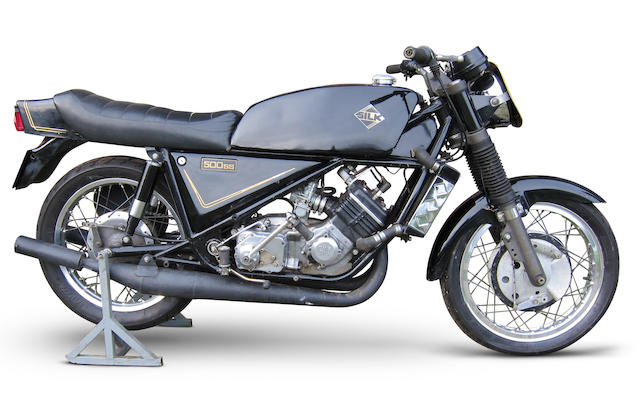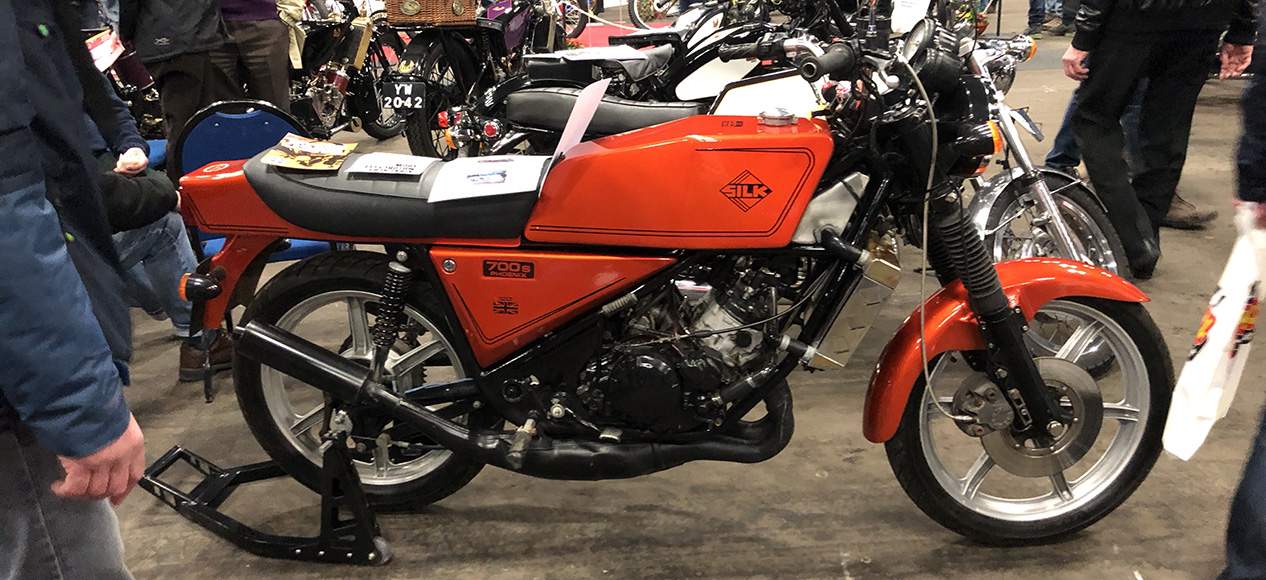The 1970s was a tough time for the British motorcycle industry.
It was the decade when years of complacency came home to roost. Honda came to the party with its CB750, the world’s first superbike, while BSA, Norton and Triumph struggled along with their aging two-cylinder designs. With industrial action throwing the British manufacturers into seemingly endless turmoil, the combination of a lack of investment, less than modern products and erratic supply saw UK riders looking elsewhere for their new bikes. Kawasaki unleashed the awesome Z1, while Suzuki and Yamaha came along with a series of sporty two-strokes. Add in some interesting imports from Italy and the writing was on the wall for the Brits, even though one plucky manufacturer tried to buck the trend.
Silk was a Derbyshire based manufacturer which produced a two-stroke twin of its own from 1975 through to 1979.
Company founder George Silk was an engineer who was famed for his work on Scotts. Scott was an early British motorbike manufacturer and, when they went bust in 1969, Silk specialised in manufacturing spare parts and performance modifications for them. He also produced a run of 21 Silk-Scotts in the early 1970s, before wrangles over copyright meant that he was forced to take a different direction. The Silk 700S was that direction.
Launched in 1975, the 700S featured a 653cc water-cooled parallel twin motor that was developed in conjunction with engineers from Rolls Royce and Queen’s University Belfast. With a launch price tag of £1355, it was the one of the most expensive motorcycles in the world and was hand built at the rate of two a week. Chassis specialist Spondon Engineering produced the steel tubular frame, as well as the forks and brake components, and contemporary reports complemented the 700S on its sweet handling.
The all-aluminium two-stroke engine was visually similar to Alfred Scott’s 60 year old Squirrel design, but incorporated plenty of the latest technology to bring it up to date. The sound was unusual for a two-stroke, with twin ‘siamesed’ pipes going into a silencer taken from a Spanish Ossa to create a soundtrack more akin to a four-stroke than a ring-a-ding stroker. Power from the piston ported engine, at least on the later bikes, was a respectable 54bhp. That was good for a claimed top speed of 111mph, although the machine was handicapped by a widely spaced four-speed gearbox, which had been repurposed from the 1950s Velocette Venom. The tall first gear was reported to be good for 50mph, however it was also said to be difficult to get off the line without stalling, despite strong torque figures., Peak torque came in at just 3,000rpm – a far cry from every other two-stroke on the market in the 1970s.

The Silk was also one of the last bastions of that great English motorcycle quirk, the right hand gearchange, and despite its hefty price tag and otherwise high specification (witness those cast alloy wheels and twin disc brakes), George Silk eschewed an electric starter for reasons of weight saving and simplicity. The kickstart was much maligned though, being canted forward and difficult to operate. Not great on a bike that could stall easily at low speeds…
By 1976, Cumbrian engineering company Furmanite International took over the business with a view to ramping up production. A MkII version of the 700S was introduced for 1977 and these made a little more power and featured a new seat, rear light design and instrument cluster, as well as finned engine barrels. The standard price for the MkII was £1984 (around £12,000 in today’s money) and being hand built, each Silk 700S had a slightly different specification. Owners were able to pick from a range of different handlebar options, five colours, two alloy fuel tank options (in 14 and 18 litre capacities) and even the choice of front brake set-up, with a drum, single disc or twin disc all available. The brochure for later machines also allowed for the fitment of a handlebar mounted fairing, upgraded instruments (with a clock and temperature gauge) and even a sidecar mounting kit.
The Silk story ended in 1979, when the accountants finally realised that the company was losing money on each and every bike sold. Silk’s engineering company had been paying the bills, but even with a price hike to almost £2500, it was reported that the business lost around £200 on each bike.
In many ways the Silk 700S summed up the British industry in the 1970s. Despite some clever people delivering healthy upgrades to an aging design, the engine’s heritage led to some outdated features, such as the right hand gearchange, the four-speed ‘box and a lack of balance shafts. Just like Triumph and Norton traded with technology that was decades old, the Silk used the same basic thermosyphon design for feeding the radiator without the need for a water pump. That technology had been developed on the 1920s Scott Squirrel, the world’s first water cooled motorcycle.
The simplicity kept the weight low (140kg, or 310lbs in Seventies speak) and the component list read like the great and good of the British industry at the time, witness Amal carburettors, Avon tyres, Smiths instruments, Lucas electrics and Girling rear shocks.
These days there is a small but strong following for Silks, with many collectors considering them to be appreciating classic motorcycles. Any bike which is expensive and rare when new (only 138 were built in total) is likely to command a place in the history books, and the nature of these machines mean that many have survived in excellent condition. Most owners cherished their machines from new, with very few being modified or abused. It’s rare to see one on the market, with bikes being advertised for up to £20,000 on the odd occasion they do turn up.
Another reason for the appeal of the Silk 700S is that it was, in effect, the ultimate development of the Scott design. Founded by prolific inventor Alfred Scott in 1908, it was known for innovative designs that were ahead of their time. The company’s two-strokes were regular winners in the early years of the Isle of Man TT races, while the Scott Squirrel – launched just before Alfred’s death in 1923 – introduced water cooling and was one of the highest performing motorcycles of its day. Silk wanted to honour Scott with his 700S, and there’s no doubt that he achieved that – much to the delight of fellow Scott aficionados.




